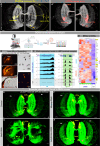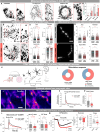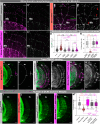Temporal transcriptional regulation of mitochondrial morphology primes activity-dependent circuit connectivity
- PMID: 40890095
- PMCID: PMC12402207
- DOI: 10.1038/s41467-025-62908-2
Temporal transcriptional regulation of mitochondrial morphology primes activity-dependent circuit connectivity
Abstract
Synaptic connectivity during development is known to require rapid local regulation of axonal organelles. Whether this fundamental and conserved aspect of neuronal cell biology is orchestrated by a dedicated developmental program is unknown. We hypothesized that developmental transcription factors regulate critical parameters of organelle structure and function which contribute to circuit wiring. We combined cell type-specific transcriptomics with a genetic screen to discover such factors. We identified Drosophila CG7101, which we rename mitochondrial integrity regulator of neuronal architecture (Mirana), as a temporal developmental regulator of neuronal mitochondrial quality control genes, including Pink1. Remarkably, a brief developmental downregulation of either Mirana or Pink1 suffices to cause long-lasting changes in mitochondrial morphology and abrogates neuronal connectivity which can be rescued by Pink1 expression. We show that Mirana has functional homology to the mammalian transcription factor TZAP whose loss leads to changes in mitochondrial function and reduced neurotransmitter release in hippocampal neurons. Our findings establish temporal developmental transcriptional regulation of mitochondrial morphology as a prerequisite for the priming and maintenance of activity-dependent synaptic connectivity.
© 2025. The Author(s).
Conflict of interest statement
Competing interests: The authors declare no competing interests.
Figures








References
MeSH terms
Substances
Grants and funding
LinkOut - more resources
Full Text Sources
Molecular Biology Databases

